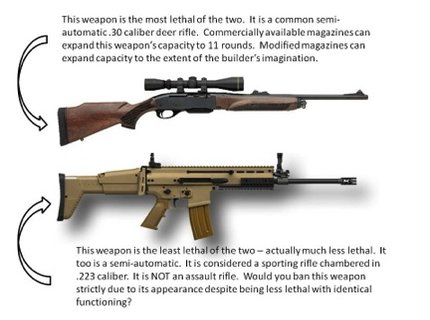
First and foremost, for anyone who would like to see relevant numbers related to firearms it is necessary for you to read “More Guns, Less Crime: Understanding Crime and Gun Control Laws (Studies in Law and Economics)” by John R. Lott Jr. The author puts all emotion aside and clearly collates decades of data to show the correlation between guns and crime.
The above mentioned book may be your first step to understanding that guns are used far more often, upward of 2.5 million times per year in the US, to deter crime rather than to commit crime. If you are able to accept the fact that guns are simply tools, then you may be ready to further educate yourself, get hands-on experience, put fear and emotion aside, and make a conscious decision about the efficacy of gun control in relation to gun rights and the utility of guns in our society.
As you could imagine, I certainly have thoughts about “bans”. The first thought is that bans of any type are generally an emotionally charged knee-jerk response of a blanket attempt at solving a problem. It should be readily apparent how well bans work when it comes to drugs being banned yet readily available across the Nation. People like to respond comparing bans in the United Kingdom, the counter to which has to do with geography and culture. The UK is a virtual island surrounded by developed nations – and guns still find their way into the hands of criminals in the UK. Violent crime has actually increased in the UK and Australia after enacting gun control. The US, on the other hand, is enormous in size, has tremendous porous borders over which human trafficking cannot be prevented let alone weapon or drug trafficking, and its culture is markedly different. Bans, regardless of duration, will not result in removing weapons – or any single type of weapon from circulation.
When it comes to banning so-called “assault weapons”, the ban has everything to do with how weapons look – their aesthetics – not how they function. It’s akin to banning Chihuahuas but not toy-poodles. The term “assault weapon” was developed as a political move to categorize weapons based on appearance. There’s nothing about an “assault weapon” that makes it any more lethal than a semi-automatic hunting rifle. What? You say all semi-automatic weapons should be banned? I invite you to search YouTube for Cowboy Action Shooting to see that pump-action weapons, lever action weapons, and single action revolvers are all capable of being fired as fast as semi-automatic weapons – and may also hold more than 11 rounds of ammunition – yes, even the revolvers. Be sure to understand what a semi-automatic weapon is – one which requires one pull of the trigger to fire one bullet. Understand that “assault weapons” are semi-automatic weapons that cannot “spray” as an automatic weapon does. Understand that automatic weapons are highly regulated in the United States and ownership is extremely rare. Again, understand that a lever-action, pump-action, and single-action can all be fired as fast as a semi-automatic weapon. “Assault weapons” are NOT weapons of war and they do not fire in selective fire mode. Furthermore, true automatic weapons are NOT designed to kill the most people in the shortest time possible – they are designed as suppressive fire weapons – to keep the oppositions heads down through volume of fire long enough for a maneuver element to close with and destroy them with precise, well-aimed, single fire shots.
When tragedy strikes we all respond emotionally. It’s important though to put emotion aside and look at a problem’s root cause or causes, the cost to mitigate those causes, and the likely outcomes of implementing those mitigating factors. To say that banning guns of any kind would reduce their availability is naïve, to say the cost to enforce the ban is worth the unlikely result is financially irresponsible, and to say that tragedy would be statistically less likely to occur as a result of a ban on any type of weapon is comparable to an ostrich hiding with its head in the sand.
The geographic boundaries of the United States coupled with its culture dictate that firearms will be present on our soil even if all guns are banned. Firearms are nothing to fear and do more good than harm on a daily basis. We should use them as tools that when put in the hands of the law-abiding, are tools that enable us to deter and defeat those who are evil. The fact that guns have the power to deter crime is justified by numbers in “More Guns, Less Crime: Understanding Crime and Gun Control Laws (Studies in Law and Economics)” by John R. Lott Jr., and show that minorities and women actually benefit greatly from enacting concealed carry laws.
Criminals tend to choose soft targets with little probability of harm to themselves. Knowing this, it is well within the realm of feasible to consider the below to mitigate active shooters in schools:
Emplace high-decibel sensors in schools that are triggered by the sound of a firearm – signaling a silent strobe-light alarm system that puts the school into active shooter response mode. Without adding additional personnel cost to schools, it could be mandatory (based on community preference) that principals and vice-principals receive defensive weapon manipulation instruction & be allowed to conceal carry at school. The same training could be optional for teachers, but teachers not allowed to conceal carry due to proximity with their students. A biometric GunVault could be bolted inside every classroom that only the teacher and principal could open (with their fingerprints) and would only contain a firearm if the teacher received the requisite training. If the principal and vice-principal choose not to carry, their weapons would be secured in a biometric GunVault in their office.
All within the realm of feasible and a relatively inexpensive solution that reduces probability of success of an assault on a school. It deters active shooters. It keeps kids safe. Yes, guns would be in the school, but they would be secured, they would only be accessible by fingerprints, a potential shooter would not know which classrooms contained guns, and potential shooters would be deterred due to high probability of being killed before accomplishing their evil intent.
Making teachers Rambos? No. Is it difficult to manipulate a firearm in a high-stress environment and effectively hit your target? Yes. However, a plan that only involves locking doors and praying is certainly a plan – but maybe not the best plan when presented with an armed shooter capable of shooting through those doors and killing the proverbial fish in a barrel. Having the means to counter a threat with an equal capability and in greater numbers is common sense – and is certainly a deterrent – and a solution in an extreme situation.
Becoming educated about firearms and embracing them as useful tools can do nothing but empower an individual. The police cannot be everywhere but are able to patrol communities to provide presence and deterrence; it’s up to the individual in their home, place of work, or school to have the means to act defensively when fractions of a second mean the difference between life and death.
Read our article on Stephen Cook and his company here…
Strength
Stephen Cook
Owner, Deenamee LLC
For more information please visit www.deenamee.com.








